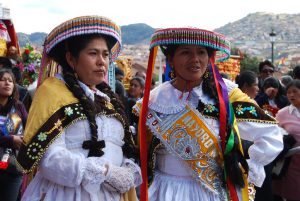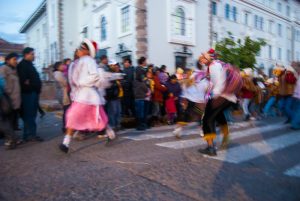Charm and Sharp Teasing, the Huaylacas of Cuzco

People participate in Cuzco’s fiestas with great courage and vigor. Some figures dance with dignity and majesty, others are athletic and energetic, while some tease and provoke. Among the latter are the maqtas and huaylacas. These are the soul of the feast. With their movements and steps they carry the feast forward, making it a joy to the end.
Both of these figures are well known and often talked about by the people. For example, the word huaylaca is used outside the feast. It does not just describe a dancer. For example, it is commonly used to describe women who do not know how to do the tasks of the home, especially those things that are considered typical of women, such as cooking, washing clothes, or caring for children. They are called huaylacas.
The term of huaylaca is used by women who have sons to describe their daughters-in-law. They may be frustrated with the homemaking skills of the women who marry into their family and so call them huaylacas.

However, today the word huaylaca refers most commonly to the figure in our dances. They dress like a woman. They wear a pollera, a traditional skirt, or sometimes dress as a mestiza collacha. Sometimes they wear a hat or a grotesque mask. Others wear the woven mask of the ukuko. They also wear, however, the sandals or shoes of a man.
They are ostensibly female but also wear items of male clothing. As a result, they are a kind of sacred clown. Their personage seems to signify a woman but they have the qualities of a man with strong and grotesque movements while walking or speaking.

They also carry on their back a baby of rags. This is called by the Quechua word, wawa, meaning baby. They may have a wooden cart or maybe a camera made from cardboard. They walk through the street and accompany the main dance troupes in the feasts. They move among the spectators and tease them. At the same time they are organizing people and keeping order.
This colorful and evocative person must have strong inner grace in order to call attention. Not everybody can wear a dress and walk down the streets trying to play the role of a woman who is not a woman.
The huaylaca had a long history in Cuzco. Every year many young men and adult males prepare to be huaylacas in the feasts or in dance troupes in Cuzco. It is a difficult and demanding role to play.

The maqtas are similar to the huaylacas. They also have the task of making people laugh, of being at the center of the feast, of keeping order, and of driving away ill-behaved people. He maqta, another sacred clown, wears the clothes of a cholito from Cuzco. However its nose is elongated and looks like a penis. They carry whips and make jokes. They will help people cross the path of the dancers and sometimes anger people who have had too much to drink.
Both of these personages, the maqta and the huaylaca are very important in our feasts and, as a result, in our culture. From generation to generation people have made these figures alive. They do so with ever more joy and art, including the art of teasing and poking fun. They study this art in order to be inside this personage and carry out everything that is part of their duties.




